Evolution of Management Thought: A Study in Educational Management
VerifiedAdded on 2023/05/30
|10
|2842
|211
Essay
AI Summary
This essay explores the evolution of management thought, tracing its origins from ancient practices to modern theories. It discusses classical approaches like scientific, administrative, and bureaucratic management, highlighting Frederick Winslow Taylor's scientific management and Henry Fayol's principles. The essay also examines behavioral, systems, and contingency approaches, including Douglas McGregor's Theory X and Theory Y. Furthermore, it delves into management functions such as planning, organizing, commanding, coordinating, and controlling, emphasizing efficiency and effectiveness in management. The document concludes by differentiating efficiency from effectiveness, providing examples within the workplace.
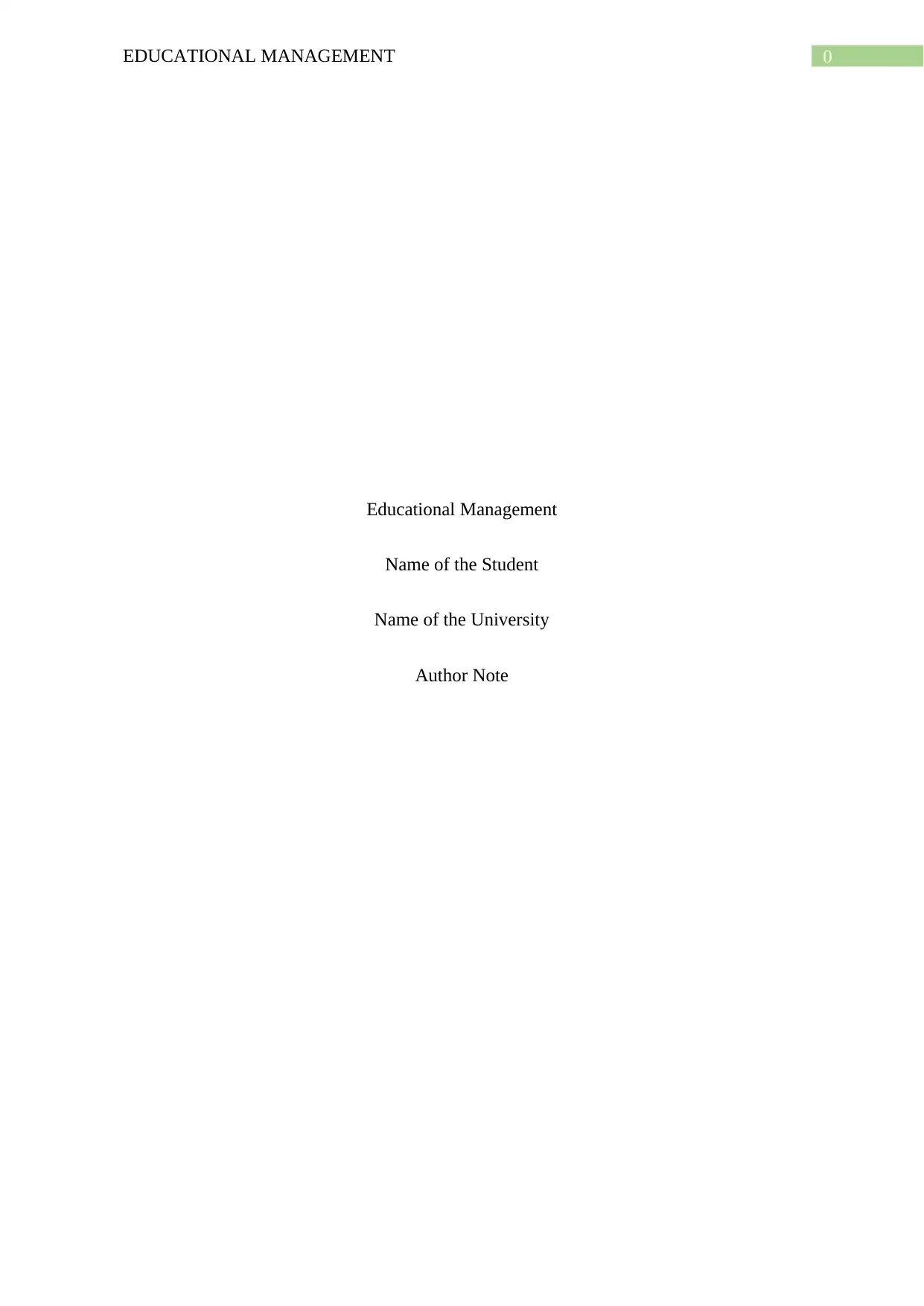
0EDUCATIONAL MANAGEMENT
Educational Management
Name of the Student
Name of the University
Author Note
Educational Management
Name of the Student
Name of the University
Author Note
Paraphrase This Document
Need a fresh take? Get an instant paraphrase of this document with our AI Paraphraser
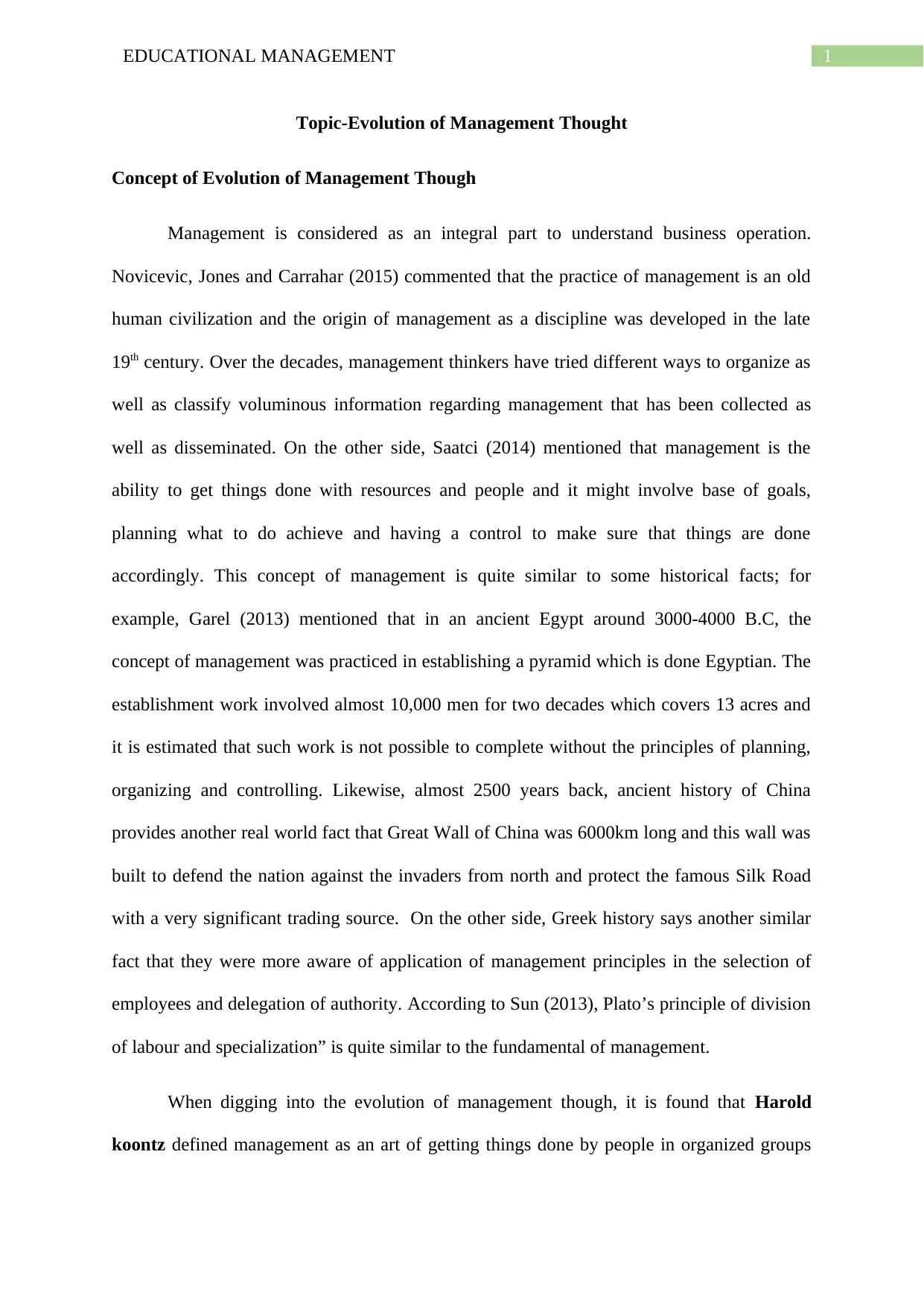
1EDUCATIONAL MANAGEMENT
Topic-Evolution of Management Thought
Concept of Evolution of Management Though
Management is considered as an integral part to understand business operation.
Novicevic, Jones and Carrahar (2015) commented that the practice of management is an old
human civilization and the origin of management as a discipline was developed in the late
19th century. Over the decades, management thinkers have tried different ways to organize as
well as classify voluminous information regarding management that has been collected as
well as disseminated. On the other side, Saatci (2014) mentioned that management is the
ability to get things done with resources and people and it might involve base of goals,
planning what to do achieve and having a control to make sure that things are done
accordingly. This concept of management is quite similar to some historical facts; for
example, Garel (2013) mentioned that in an ancient Egypt around 3000-4000 B.C, the
concept of management was practiced in establishing a pyramid which is done Egyptian. The
establishment work involved almost 10,000 men for two decades which covers 13 acres and
it is estimated that such work is not possible to complete without the principles of planning,
organizing and controlling. Likewise, almost 2500 years back, ancient history of China
provides another real world fact that Great Wall of China was 6000km long and this wall was
built to defend the nation against the invaders from north and protect the famous Silk Road
with a very significant trading source. On the other side, Greek history says another similar
fact that they were more aware of application of management principles in the selection of
employees and delegation of authority. According to Sun (2013), Plato’s principle of division
of labour and specialization” is quite similar to the fundamental of management.
When digging into the evolution of management though, it is found that Harold
koontz defined management as an art of getting things done by people in organized groups
Topic-Evolution of Management Thought
Concept of Evolution of Management Though
Management is considered as an integral part to understand business operation.
Novicevic, Jones and Carrahar (2015) commented that the practice of management is an old
human civilization and the origin of management as a discipline was developed in the late
19th century. Over the decades, management thinkers have tried different ways to organize as
well as classify voluminous information regarding management that has been collected as
well as disseminated. On the other side, Saatci (2014) mentioned that management is the
ability to get things done with resources and people and it might involve base of goals,
planning what to do achieve and having a control to make sure that things are done
accordingly. This concept of management is quite similar to some historical facts; for
example, Garel (2013) mentioned that in an ancient Egypt around 3000-4000 B.C, the
concept of management was practiced in establishing a pyramid which is done Egyptian. The
establishment work involved almost 10,000 men for two decades which covers 13 acres and
it is estimated that such work is not possible to complete without the principles of planning,
organizing and controlling. Likewise, almost 2500 years back, ancient history of China
provides another real world fact that Great Wall of China was 6000km long and this wall was
built to defend the nation against the invaders from north and protect the famous Silk Road
with a very significant trading source. On the other side, Greek history says another similar
fact that they were more aware of application of management principles in the selection of
employees and delegation of authority. According to Sun (2013), Plato’s principle of division
of labour and specialization” is quite similar to the fundamental of management.
When digging into the evolution of management though, it is found that Harold
koontz defined management as an art of getting things done by people in organized groups
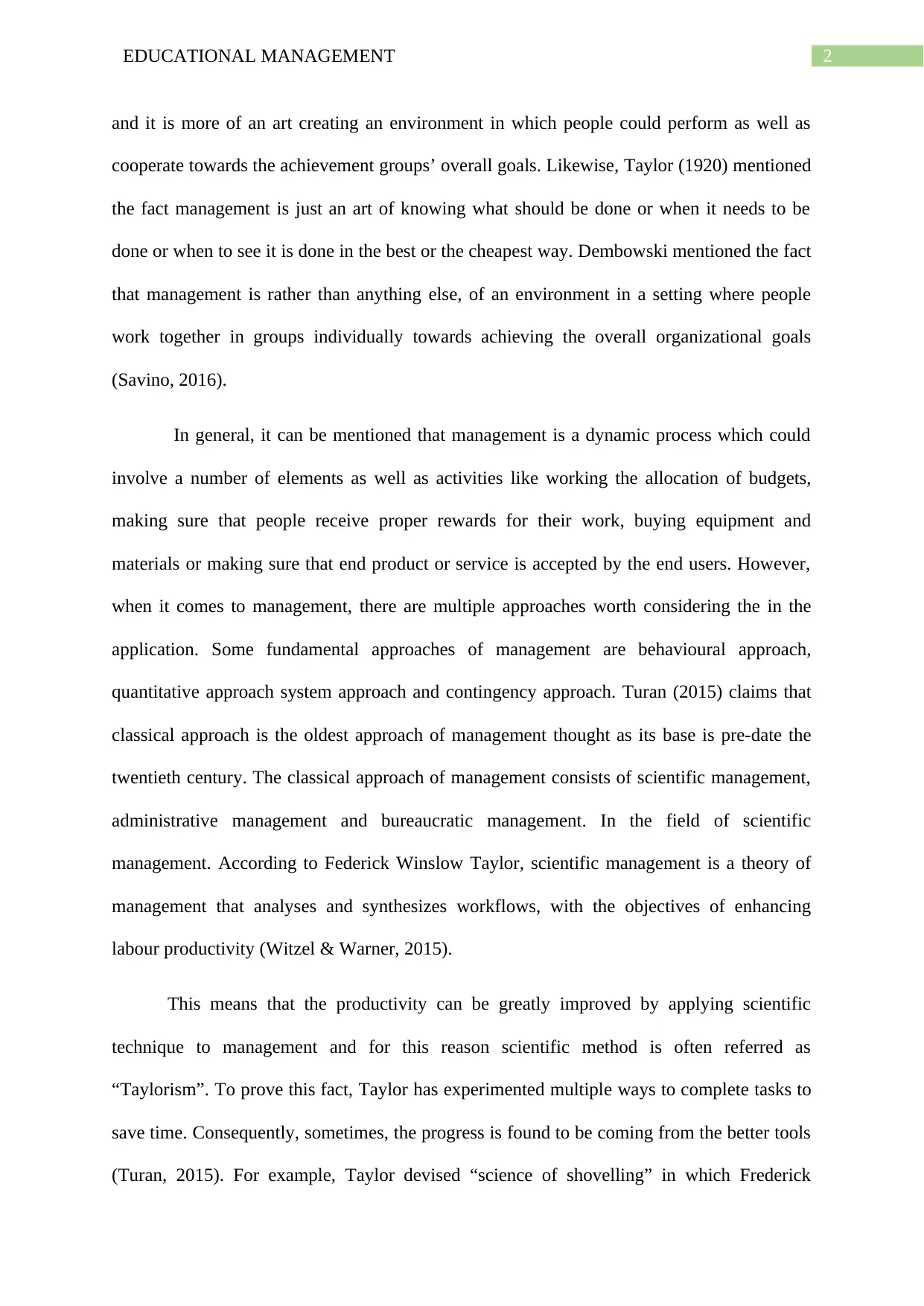
2EDUCATIONAL MANAGEMENT
and it is more of an art creating an environment in which people could perform as well as
cooperate towards the achievement groups’ overall goals. Likewise, Taylor (1920) mentioned
the fact management is just an art of knowing what should be done or when it needs to be
done or when to see it is done in the best or the cheapest way. Dembowski mentioned the fact
that management is rather than anything else, of an environment in a setting where people
work together in groups individually towards achieving the overall organizational goals
(Savino, 2016).
In general, it can be mentioned that management is a dynamic process which could
involve a number of elements as well as activities like working the allocation of budgets,
making sure that people receive proper rewards for their work, buying equipment and
materials or making sure that end product or service is accepted by the end users. However,
when it comes to management, there are multiple approaches worth considering the in the
application. Some fundamental approaches of management are behavioural approach,
quantitative approach system approach and contingency approach. Turan (2015) claims that
classical approach is the oldest approach of management thought as its base is pre-date the
twentieth century. The classical approach of management consists of scientific management,
administrative management and bureaucratic management. In the field of scientific
management. According to Federick Winslow Taylor, scientific management is a theory of
management that analyses and synthesizes workflows, with the objectives of enhancing
labour productivity (Witzel & Warner, 2015).
This means that the productivity can be greatly improved by applying scientific
technique to management and for this reason scientific method is often referred as
“Taylorism”. To prove this fact, Taylor has experimented multiple ways to complete tasks to
save time. Consequently, sometimes, the progress is found to be coming from the better tools
(Turan, 2015). For example, Taylor devised “science of shovelling” in which Frederick
and it is more of an art creating an environment in which people could perform as well as
cooperate towards the achievement groups’ overall goals. Likewise, Taylor (1920) mentioned
the fact management is just an art of knowing what should be done or when it needs to be
done or when to see it is done in the best or the cheapest way. Dembowski mentioned the fact
that management is rather than anything else, of an environment in a setting where people
work together in groups individually towards achieving the overall organizational goals
(Savino, 2016).
In general, it can be mentioned that management is a dynamic process which could
involve a number of elements as well as activities like working the allocation of budgets,
making sure that people receive proper rewards for their work, buying equipment and
materials or making sure that end product or service is accepted by the end users. However,
when it comes to management, there are multiple approaches worth considering the in the
application. Some fundamental approaches of management are behavioural approach,
quantitative approach system approach and contingency approach. Turan (2015) claims that
classical approach is the oldest approach of management thought as its base is pre-date the
twentieth century. The classical approach of management consists of scientific management,
administrative management and bureaucratic management. In the field of scientific
management. According to Federick Winslow Taylor, scientific management is a theory of
management that analyses and synthesizes workflows, with the objectives of enhancing
labour productivity (Witzel & Warner, 2015).
This means that the productivity can be greatly improved by applying scientific
technique to management and for this reason scientific method is often referred as
“Taylorism”. To prove this fact, Taylor has experimented multiple ways to complete tasks to
save time. Consequently, sometimes, the progress is found to be coming from the better tools
(Turan, 2015). For example, Taylor devised “science of shovelling” in which Frederick
⊘ This is a preview!⊘
Do you want full access?
Subscribe today to unlock all pages.

Trusted by 1+ million students worldwide
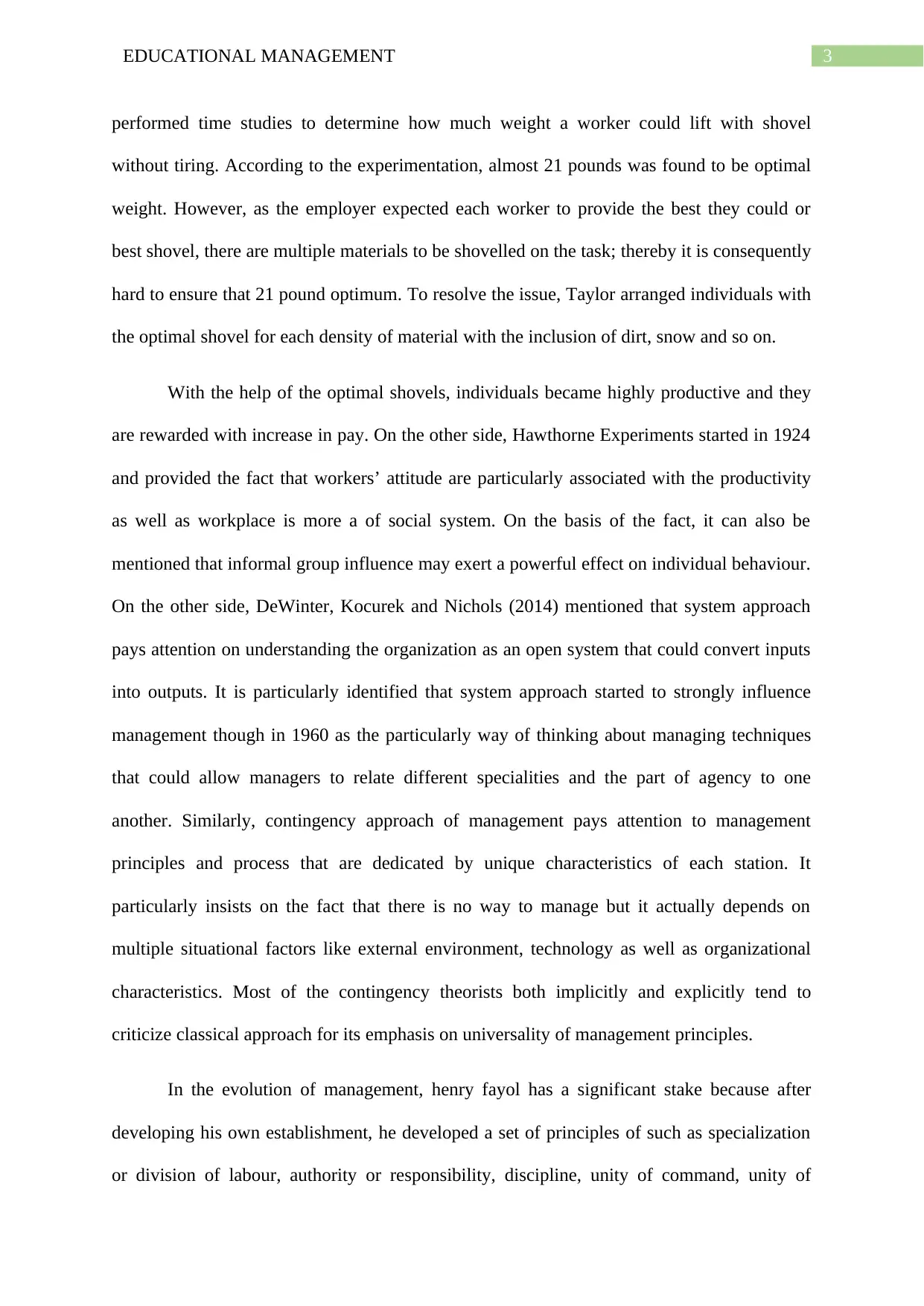
3EDUCATIONAL MANAGEMENT
performed time studies to determine how much weight a worker could lift with shovel
without tiring. According to the experimentation, almost 21 pounds was found to be optimal
weight. However, as the employer expected each worker to provide the best they could or
best shovel, there are multiple materials to be shovelled on the task; thereby it is consequently
hard to ensure that 21 pound optimum. To resolve the issue, Taylor arranged individuals with
the optimal shovel for each density of material with the inclusion of dirt, snow and so on.
With the help of the optimal shovels, individuals became highly productive and they
are rewarded with increase in pay. On the other side, Hawthorne Experiments started in 1924
and provided the fact that workers’ attitude are particularly associated with the productivity
as well as workplace is more a of social system. On the basis of the fact, it can also be
mentioned that informal group influence may exert a powerful effect on individual behaviour.
On the other side, DeWinter, Kocurek and Nichols (2014) mentioned that system approach
pays attention on understanding the organization as an open system that could convert inputs
into outputs. It is particularly identified that system approach started to strongly influence
management though in 1960 as the particularly way of thinking about managing techniques
that could allow managers to relate different specialities and the part of agency to one
another. Similarly, contingency approach of management pays attention to management
principles and process that are dedicated by unique characteristics of each station. It
particularly insists on the fact that there is no way to manage but it actually depends on
multiple situational factors like external environment, technology as well as organizational
characteristics. Most of the contingency theorists both implicitly and explicitly tend to
criticize classical approach for its emphasis on universality of management principles.
In the evolution of management, henry fayol has a significant stake because after
developing his own establishment, he developed a set of principles of such as specialization
or division of labour, authority or responsibility, discipline, unity of command, unity of
performed time studies to determine how much weight a worker could lift with shovel
without tiring. According to the experimentation, almost 21 pounds was found to be optimal
weight. However, as the employer expected each worker to provide the best they could or
best shovel, there are multiple materials to be shovelled on the task; thereby it is consequently
hard to ensure that 21 pound optimum. To resolve the issue, Taylor arranged individuals with
the optimal shovel for each density of material with the inclusion of dirt, snow and so on.
With the help of the optimal shovels, individuals became highly productive and they
are rewarded with increase in pay. On the other side, Hawthorne Experiments started in 1924
and provided the fact that workers’ attitude are particularly associated with the productivity
as well as workplace is more a of social system. On the basis of the fact, it can also be
mentioned that informal group influence may exert a powerful effect on individual behaviour.
On the other side, DeWinter, Kocurek and Nichols (2014) mentioned that system approach
pays attention on understanding the organization as an open system that could convert inputs
into outputs. It is particularly identified that system approach started to strongly influence
management though in 1960 as the particularly way of thinking about managing techniques
that could allow managers to relate different specialities and the part of agency to one
another. Similarly, contingency approach of management pays attention to management
principles and process that are dedicated by unique characteristics of each station. It
particularly insists on the fact that there is no way to manage but it actually depends on
multiple situational factors like external environment, technology as well as organizational
characteristics. Most of the contingency theorists both implicitly and explicitly tend to
criticize classical approach for its emphasis on universality of management principles.
In the evolution of management, henry fayol has a significant stake because after
developing his own establishment, he developed a set of principles of such as specialization
or division of labour, authority or responsibility, discipline, unity of command, unity of
Paraphrase This Document
Need a fresh take? Get an instant paraphrase of this document with our AI Paraphraser
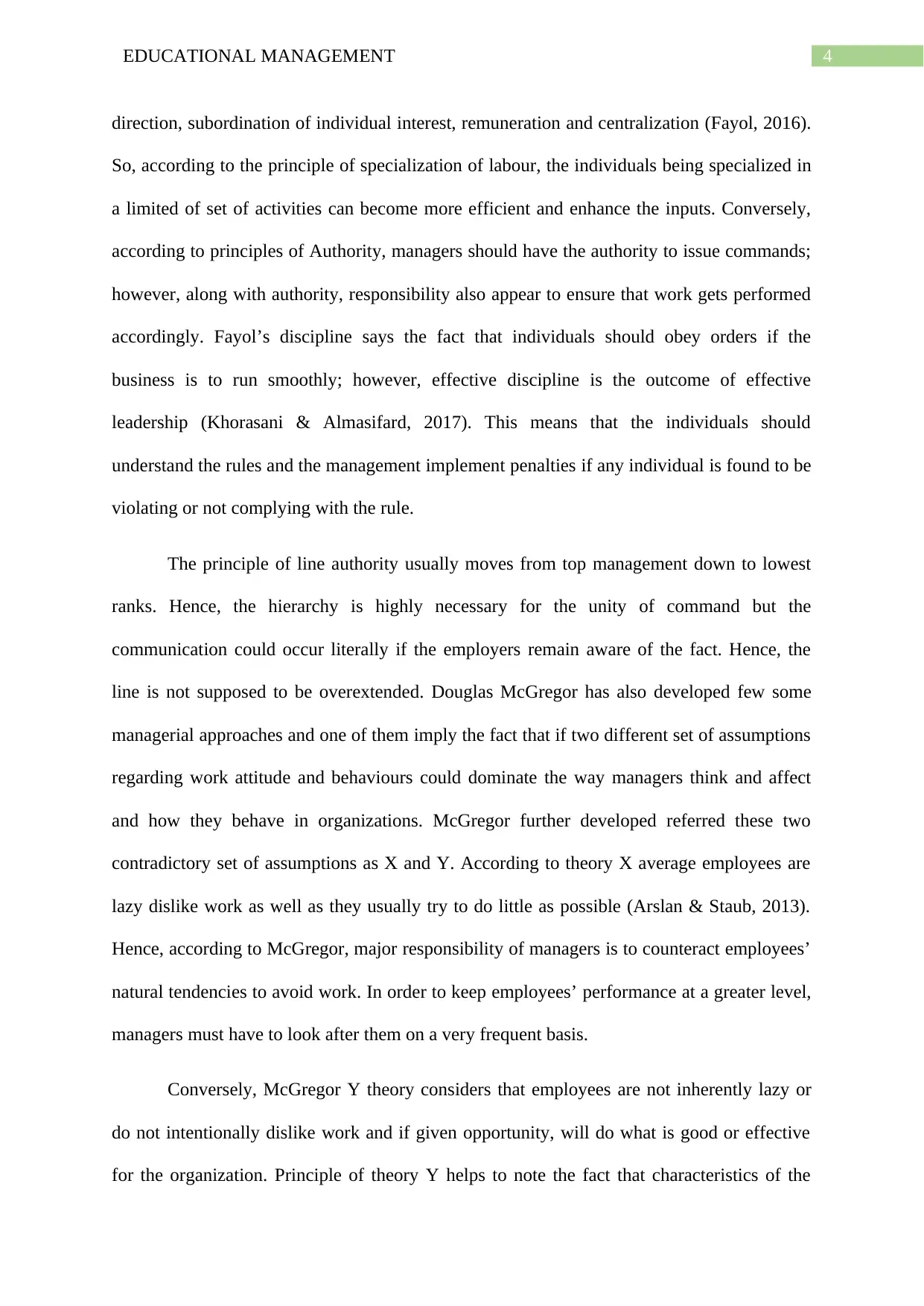
4EDUCATIONAL MANAGEMENT
direction, subordination of individual interest, remuneration and centralization (Fayol, 2016).
So, according to the principle of specialization of labour, the individuals being specialized in
a limited of set of activities can become more efficient and enhance the inputs. Conversely,
according to principles of Authority, managers should have the authority to issue commands;
however, along with authority, responsibility also appear to ensure that work gets performed
accordingly. Fayol’s discipline says the fact that individuals should obey orders if the
business is to run smoothly; however, effective discipline is the outcome of effective
leadership (Khorasani & Almasifard, 2017). This means that the individuals should
understand the rules and the management implement penalties if any individual is found to be
violating or not complying with the rule.
The principle of line authority usually moves from top management down to lowest
ranks. Hence, the hierarchy is highly necessary for the unity of command but the
communication could occur literally if the employers remain aware of the fact. Hence, the
line is not supposed to be overextended. Douglas McGregor has also developed few some
managerial approaches and one of them imply the fact that if two different set of assumptions
regarding work attitude and behaviours could dominate the way managers think and affect
and how they behave in organizations. McGregor further developed referred these two
contradictory set of assumptions as X and Y. According to theory X average employees are
lazy dislike work as well as they usually try to do little as possible (Arslan & Staub, 2013).
Hence, according to McGregor, major responsibility of managers is to counteract employees’
natural tendencies to avoid work. In order to keep employees’ performance at a greater level,
managers must have to look after them on a very frequent basis.
Conversely, McGregor Y theory considers that employees are not inherently lazy or
do not intentionally dislike work and if given opportunity, will do what is good or effective
for the organization. Principle of theory Y helps to note the fact that characteristics of the
direction, subordination of individual interest, remuneration and centralization (Fayol, 2016).
So, according to the principle of specialization of labour, the individuals being specialized in
a limited of set of activities can become more efficient and enhance the inputs. Conversely,
according to principles of Authority, managers should have the authority to issue commands;
however, along with authority, responsibility also appear to ensure that work gets performed
accordingly. Fayol’s discipline says the fact that individuals should obey orders if the
business is to run smoothly; however, effective discipline is the outcome of effective
leadership (Khorasani & Almasifard, 2017). This means that the individuals should
understand the rules and the management implement penalties if any individual is found to be
violating or not complying with the rule.
The principle of line authority usually moves from top management down to lowest
ranks. Hence, the hierarchy is highly necessary for the unity of command but the
communication could occur literally if the employers remain aware of the fact. Hence, the
line is not supposed to be overextended. Douglas McGregor has also developed few some
managerial approaches and one of them imply the fact that if two different set of assumptions
regarding work attitude and behaviours could dominate the way managers think and affect
and how they behave in organizations. McGregor further developed referred these two
contradictory set of assumptions as X and Y. According to theory X average employees are
lazy dislike work as well as they usually try to do little as possible (Arslan & Staub, 2013).
Hence, according to McGregor, major responsibility of managers is to counteract employees’
natural tendencies to avoid work. In order to keep employees’ performance at a greater level,
managers must have to look after them on a very frequent basis.
Conversely, McGregor Y theory considers that employees are not inherently lazy or
do not intentionally dislike work and if given opportunity, will do what is good or effective
for the organization. Principle of theory Y helps to note the fact that characteristics of the
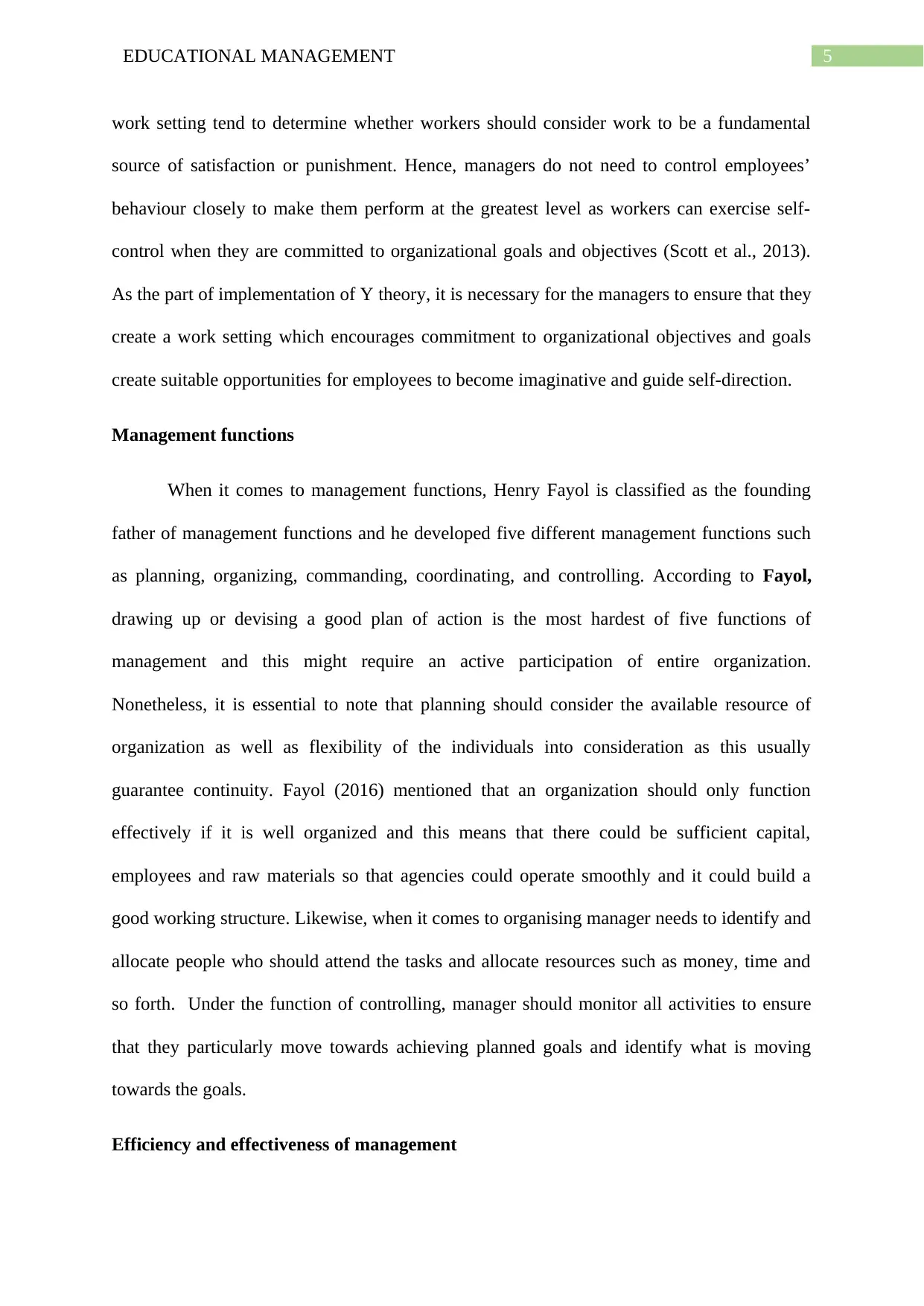
5EDUCATIONAL MANAGEMENT
work setting tend to determine whether workers should consider work to be a fundamental
source of satisfaction or punishment. Hence, managers do not need to control employees’
behaviour closely to make them perform at the greatest level as workers can exercise self-
control when they are committed to organizational goals and objectives (Scott et al., 2013).
As the part of implementation of Y theory, it is necessary for the managers to ensure that they
create a work setting which encourages commitment to organizational objectives and goals
create suitable opportunities for employees to become imaginative and guide self-direction.
Management functions
When it comes to management functions, Henry Fayol is classified as the founding
father of management functions and he developed five different management functions such
as planning, organizing, commanding, coordinating, and controlling. According to Fayol,
drawing up or devising a good plan of action is the most hardest of five functions of
management and this might require an active participation of entire organization.
Nonetheless, it is essential to note that planning should consider the available resource of
organization as well as flexibility of the individuals into consideration as this usually
guarantee continuity. Fayol (2016) mentioned that an organization should only function
effectively if it is well organized and this means that there could be sufficient capital,
employees and raw materials so that agencies could operate smoothly and it could build a
good working structure. Likewise, when it comes to organising manager needs to identify and
allocate people who should attend the tasks and allocate resources such as money, time and
so forth. Under the function of controlling, manager should monitor all activities to ensure
that they particularly move towards achieving planned goals and identify what is moving
towards the goals.
Efficiency and effectiveness of management
work setting tend to determine whether workers should consider work to be a fundamental
source of satisfaction or punishment. Hence, managers do not need to control employees’
behaviour closely to make them perform at the greatest level as workers can exercise self-
control when they are committed to organizational goals and objectives (Scott et al., 2013).
As the part of implementation of Y theory, it is necessary for the managers to ensure that they
create a work setting which encourages commitment to organizational objectives and goals
create suitable opportunities for employees to become imaginative and guide self-direction.
Management functions
When it comes to management functions, Henry Fayol is classified as the founding
father of management functions and he developed five different management functions such
as planning, organizing, commanding, coordinating, and controlling. According to Fayol,
drawing up or devising a good plan of action is the most hardest of five functions of
management and this might require an active participation of entire organization.
Nonetheless, it is essential to note that planning should consider the available resource of
organization as well as flexibility of the individuals into consideration as this usually
guarantee continuity. Fayol (2016) mentioned that an organization should only function
effectively if it is well organized and this means that there could be sufficient capital,
employees and raw materials so that agencies could operate smoothly and it could build a
good working structure. Likewise, when it comes to organising manager needs to identify and
allocate people who should attend the tasks and allocate resources such as money, time and
so forth. Under the function of controlling, manager should monitor all activities to ensure
that they particularly move towards achieving planned goals and identify what is moving
towards the goals.
Efficiency and effectiveness of management
⊘ This is a preview!⊘
Do you want full access?
Subscribe today to unlock all pages.

Trusted by 1+ million students worldwide
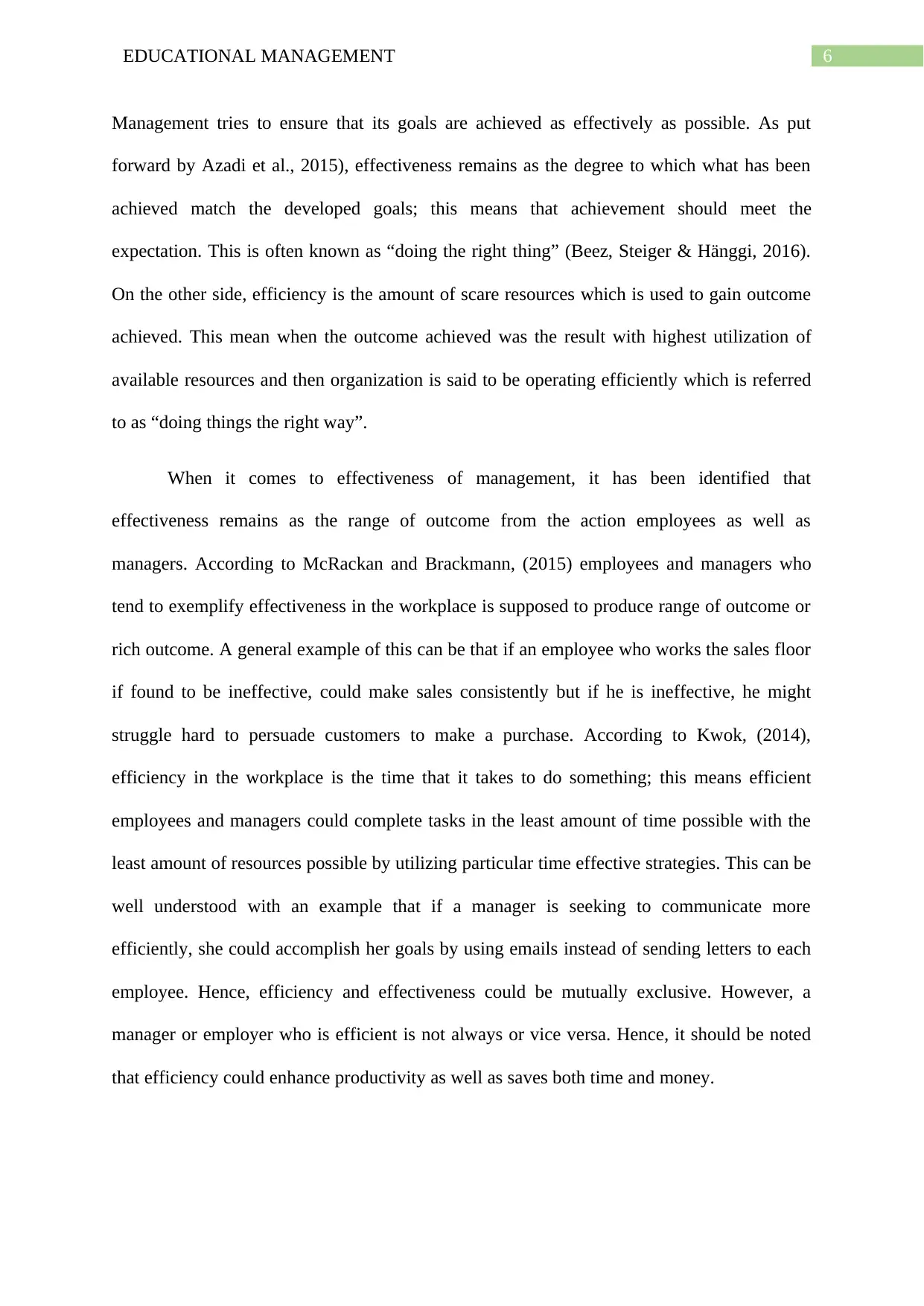
6EDUCATIONAL MANAGEMENT
Management tries to ensure that its goals are achieved as effectively as possible. As put
forward by Azadi et al., 2015), effectiveness remains as the degree to which what has been
achieved match the developed goals; this means that achievement should meet the
expectation. This is often known as “doing the right thing” (Beez, Steiger & Hänggi, 2016).
On the other side, efficiency is the amount of scare resources which is used to gain outcome
achieved. This mean when the outcome achieved was the result with highest utilization of
available resources and then organization is said to be operating efficiently which is referred
to as “doing things the right way”.
When it comes to effectiveness of management, it has been identified that
effectiveness remains as the range of outcome from the action employees as well as
managers. According to McRackan and Brackmann, (2015) employees and managers who
tend to exemplify effectiveness in the workplace is supposed to produce range of outcome or
rich outcome. A general example of this can be that if an employee who works the sales floor
if found to be ineffective, could make sales consistently but if he is ineffective, he might
struggle hard to persuade customers to make a purchase. According to Kwok, (2014),
efficiency in the workplace is the time that it takes to do something; this means efficient
employees and managers could complete tasks in the least amount of time possible with the
least amount of resources possible by utilizing particular time effective strategies. This can be
well understood with an example that if a manager is seeking to communicate more
efficiently, she could accomplish her goals by using emails instead of sending letters to each
employee. Hence, efficiency and effectiveness could be mutually exclusive. However, a
manager or employer who is efficient is not always or vice versa. Hence, it should be noted
that efficiency could enhance productivity as well as saves both time and money.
Management tries to ensure that its goals are achieved as effectively as possible. As put
forward by Azadi et al., 2015), effectiveness remains as the degree to which what has been
achieved match the developed goals; this means that achievement should meet the
expectation. This is often known as “doing the right thing” (Beez, Steiger & Hänggi, 2016).
On the other side, efficiency is the amount of scare resources which is used to gain outcome
achieved. This mean when the outcome achieved was the result with highest utilization of
available resources and then organization is said to be operating efficiently which is referred
to as “doing things the right way”.
When it comes to effectiveness of management, it has been identified that
effectiveness remains as the range of outcome from the action employees as well as
managers. According to McRackan and Brackmann, (2015) employees and managers who
tend to exemplify effectiveness in the workplace is supposed to produce range of outcome or
rich outcome. A general example of this can be that if an employee who works the sales floor
if found to be ineffective, could make sales consistently but if he is ineffective, he might
struggle hard to persuade customers to make a purchase. According to Kwok, (2014),
efficiency in the workplace is the time that it takes to do something; this means efficient
employees and managers could complete tasks in the least amount of time possible with the
least amount of resources possible by utilizing particular time effective strategies. This can be
well understood with an example that if a manager is seeking to communicate more
efficiently, she could accomplish her goals by using emails instead of sending letters to each
employee. Hence, efficiency and effectiveness could be mutually exclusive. However, a
manager or employer who is efficient is not always or vice versa. Hence, it should be noted
that efficiency could enhance productivity as well as saves both time and money.
Paraphrase This Document
Need a fresh take? Get an instant paraphrase of this document with our AI Paraphraser
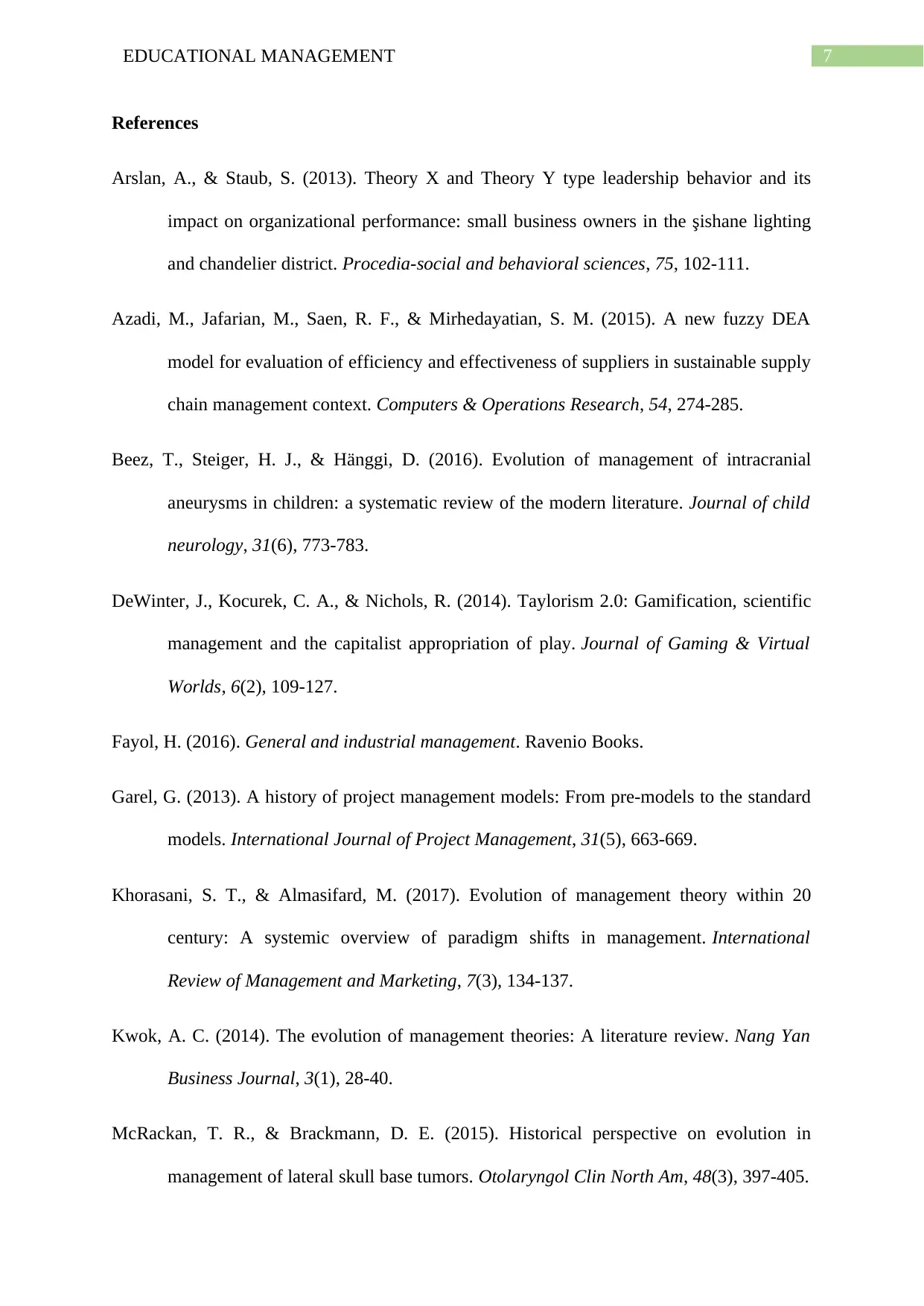
7EDUCATIONAL MANAGEMENT
References
Arslan, A., & Staub, S. (2013). Theory X and Theory Y type leadership behavior and its
impact on organizational performance: small business owners in the şishane lighting
and chandelier district. Procedia-social and behavioral sciences, 75, 102-111.
Azadi, M., Jafarian, M., Saen, R. F., & Mirhedayatian, S. M. (2015). A new fuzzy DEA
model for evaluation of efficiency and effectiveness of suppliers in sustainable supply
chain management context. Computers & Operations Research, 54, 274-285.
Beez, T., Steiger, H. J., & Hänggi, D. (2016). Evolution of management of intracranial
aneurysms in children: a systematic review of the modern literature. Journal of child
neurology, 31(6), 773-783.
DeWinter, J., Kocurek, C. A., & Nichols, R. (2014). Taylorism 2.0: Gamification, scientific
management and the capitalist appropriation of play. Journal of Gaming & Virtual
Worlds, 6(2), 109-127.
Fayol, H. (2016). General and industrial management. Ravenio Books.
Garel, G. (2013). A history of project management models: From pre-models to the standard
models. International Journal of Project Management, 31(5), 663-669.
Khorasani, S. T., & Almasifard, M. (2017). Evolution of management theory within 20
century: A systemic overview of paradigm shifts in management. International
Review of Management and Marketing, 7(3), 134-137.
Kwok, A. C. (2014). The evolution of management theories: A literature review. Nang Yan
Business Journal, 3(1), 28-40.
McRackan, T. R., & Brackmann, D. E. (2015). Historical perspective on evolution in
management of lateral skull base tumors. Otolaryngol Clin North Am, 48(3), 397-405.
References
Arslan, A., & Staub, S. (2013). Theory X and Theory Y type leadership behavior and its
impact on organizational performance: small business owners in the şishane lighting
and chandelier district. Procedia-social and behavioral sciences, 75, 102-111.
Azadi, M., Jafarian, M., Saen, R. F., & Mirhedayatian, S. M. (2015). A new fuzzy DEA
model for evaluation of efficiency and effectiveness of suppliers in sustainable supply
chain management context. Computers & Operations Research, 54, 274-285.
Beez, T., Steiger, H. J., & Hänggi, D. (2016). Evolution of management of intracranial
aneurysms in children: a systematic review of the modern literature. Journal of child
neurology, 31(6), 773-783.
DeWinter, J., Kocurek, C. A., & Nichols, R. (2014). Taylorism 2.0: Gamification, scientific
management and the capitalist appropriation of play. Journal of Gaming & Virtual
Worlds, 6(2), 109-127.
Fayol, H. (2016). General and industrial management. Ravenio Books.
Garel, G. (2013). A history of project management models: From pre-models to the standard
models. International Journal of Project Management, 31(5), 663-669.
Khorasani, S. T., & Almasifard, M. (2017). Evolution of management theory within 20
century: A systemic overview of paradigm shifts in management. International
Review of Management and Marketing, 7(3), 134-137.
Kwok, A. C. (2014). The evolution of management theories: A literature review. Nang Yan
Business Journal, 3(1), 28-40.
McRackan, T. R., & Brackmann, D. E. (2015). Historical perspective on evolution in
management of lateral skull base tumors. Otolaryngol Clin North Am, 48(3), 397-405.
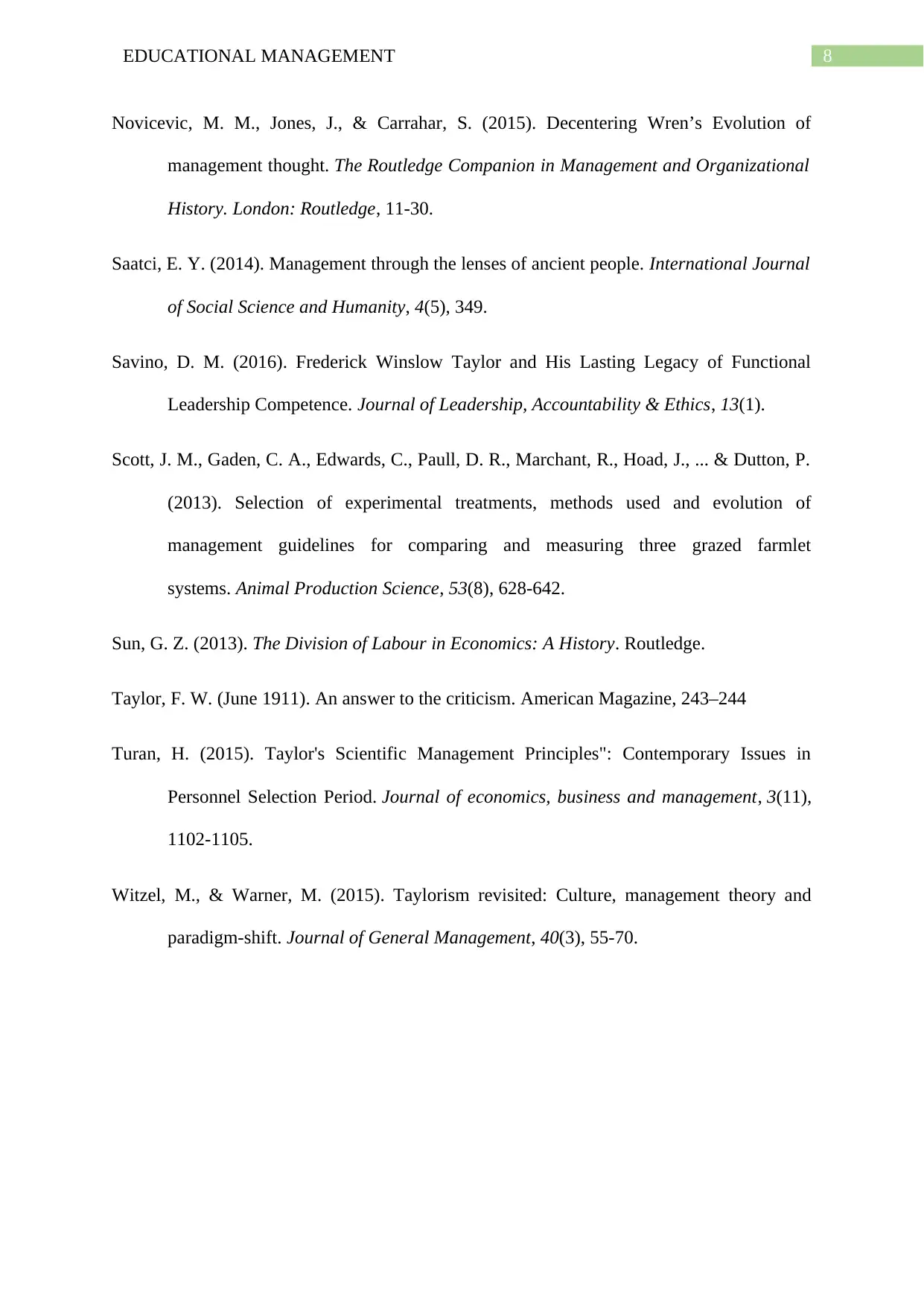
8EDUCATIONAL MANAGEMENT
Novicevic, M. M., Jones, J., & Carrahar, S. (2015). Decentering Wren’s Evolution of
management thought. The Routledge Companion in Management and Organizational
History. London: Routledge, 11-30.
Saatci, E. Y. (2014). Management through the lenses of ancient people. International Journal
of Social Science and Humanity, 4(5), 349.
Savino, D. M. (2016). Frederick Winslow Taylor and His Lasting Legacy of Functional
Leadership Competence. Journal of Leadership, Accountability & Ethics, 13(1).
Scott, J. M., Gaden, C. A., Edwards, C., Paull, D. R., Marchant, R., Hoad, J., ... & Dutton, P.
(2013). Selection of experimental treatments, methods used and evolution of
management guidelines for comparing and measuring three grazed farmlet
systems. Animal Production Science, 53(8), 628-642.
Sun, G. Z. (2013). The Division of Labour in Economics: A History. Routledge.
Taylor, F. W. (June 1911). An answer to the criticism. American Magazine, 243–244
Turan, H. (2015). Taylor's Scientific Management Principles": Contemporary Issues in
Personnel Selection Period. Journal of economics, business and management, 3(11),
1102-1105.
Witzel, M., & Warner, M. (2015). Taylorism revisited: Culture, management theory and
paradigm-shift. Journal of General Management, 40(3), 55-70.
Novicevic, M. M., Jones, J., & Carrahar, S. (2015). Decentering Wren’s Evolution of
management thought. The Routledge Companion in Management and Organizational
History. London: Routledge, 11-30.
Saatci, E. Y. (2014). Management through the lenses of ancient people. International Journal
of Social Science and Humanity, 4(5), 349.
Savino, D. M. (2016). Frederick Winslow Taylor and His Lasting Legacy of Functional
Leadership Competence. Journal of Leadership, Accountability & Ethics, 13(1).
Scott, J. M., Gaden, C. A., Edwards, C., Paull, D. R., Marchant, R., Hoad, J., ... & Dutton, P.
(2013). Selection of experimental treatments, methods used and evolution of
management guidelines for comparing and measuring three grazed farmlet
systems. Animal Production Science, 53(8), 628-642.
Sun, G. Z. (2013). The Division of Labour in Economics: A History. Routledge.
Taylor, F. W. (June 1911). An answer to the criticism. American Magazine, 243–244
Turan, H. (2015). Taylor's Scientific Management Principles": Contemporary Issues in
Personnel Selection Period. Journal of economics, business and management, 3(11),
1102-1105.
Witzel, M., & Warner, M. (2015). Taylorism revisited: Culture, management theory and
paradigm-shift. Journal of General Management, 40(3), 55-70.
⊘ This is a preview!⊘
Do you want full access?
Subscribe today to unlock all pages.

Trusted by 1+ million students worldwide
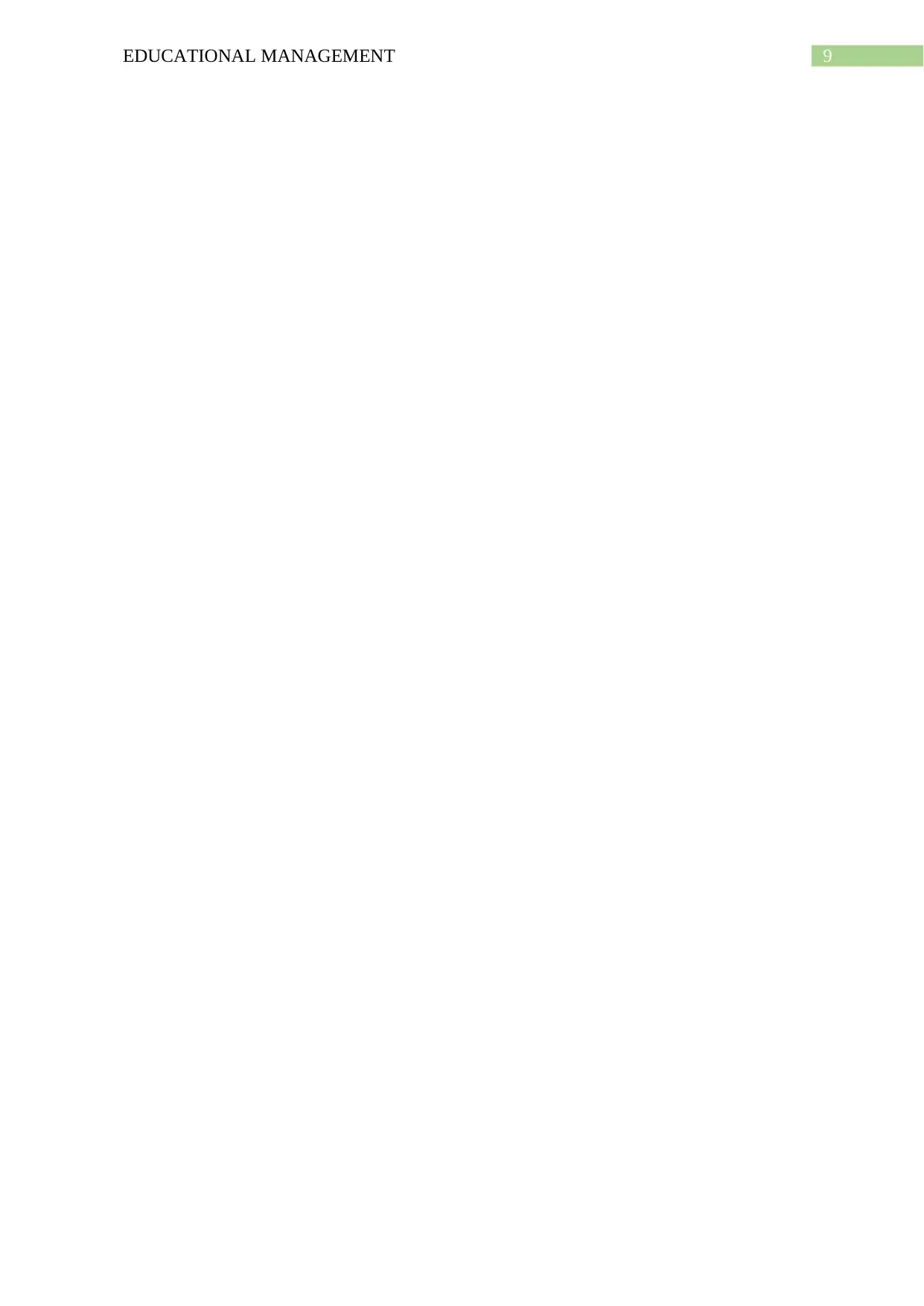
9EDUCATIONAL MANAGEMENT
1 out of 10
Your All-in-One AI-Powered Toolkit for Academic Success.
+13062052269
info@desklib.com
Available 24*7 on WhatsApp / Email
![[object Object]](/_next/static/media/star-bottom.7253800d.svg)
Unlock your academic potential
Copyright © 2020–2025 A2Z Services. All Rights Reserved. Developed and managed by ZUCOL.

